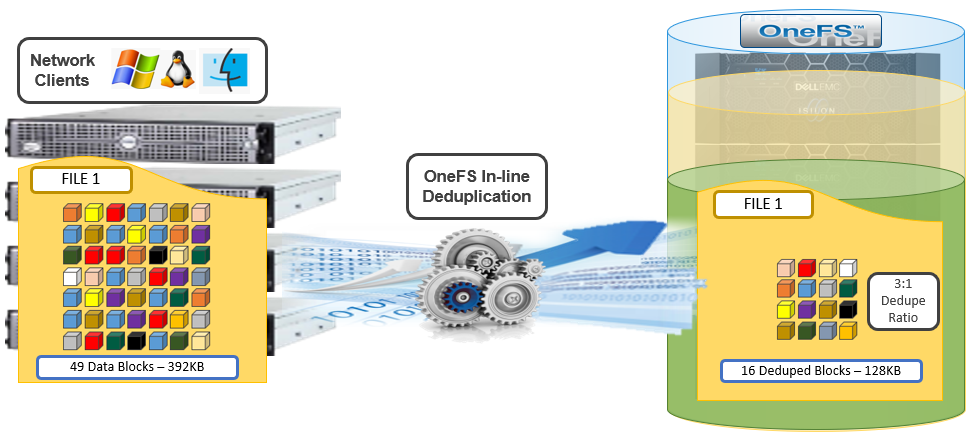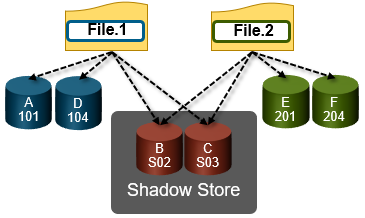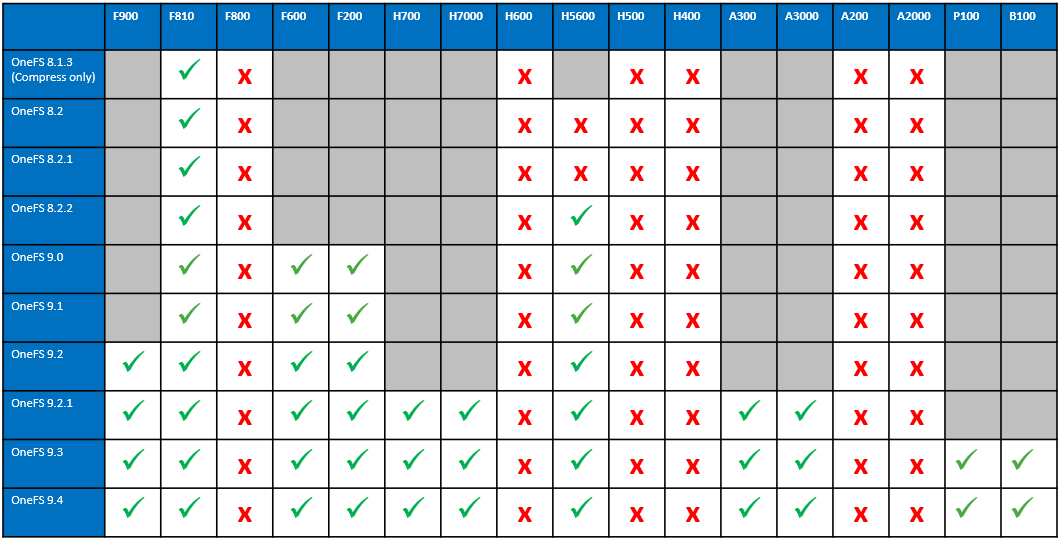Among the features and functionality delivered in the new OneFS 9.4 release is the promotion of inline dedupe to enabled by default, further enhancing PowerScale’s dollar per TB economics, rack density, and value.
Part of the OneFS data reduction suite, inline dedupe initially debuted in OneFS 8.2.1. However, until now, it needed to be manually enabled, so often customers simply didn’t use it. However, with this enhancement, new clusters running OneFS 9.4 will now have inline dedupe on by default.
| Cluster Configuration | Inline Dedupe | Inline Compression |
| New cluster running OneFS 9.4 | Enabled | Enabled |
| New cluster running OneFS 9.3 or earlier | Disabled | Enabled |
| Cluster with inline dedupe enabled that is upgraded to OneFS 9.4 | Enabled | Enabled |
| Cluster with inline dedupe disabled that is upgraded to OneFS 9.4 | Disabled | Enabled |
That said, any clusters that upgrade to 9.4 will not see any change to their current inline dedupe config during upgrade. Additionally, there is also no change to the behavior for inline compression, which remains enabled by default in all OneFS versions from 8.1.3 onwards.
But before we examine the under the hood changes in OneFS 9.4, first, a quick dedupe refresher.
Currently OneFS inline data reduction, which encompasses compression, dedupe, and zero block removal, is supported on the F900, F600, F200 all-flash nodes, plus the F810, H5600, H700/7000, and A300/3000 Gen6.x chassis.

Within the OneFS data reduction pipeline, zero block removal is performed first, followed by dedupe, and then compression, and this order allows each phase to reduce the scope of work each subsequent phase.
Unlike SmartDedupe, which performs deduplication once data has been written to disk, or post-process, inline dedupe acts in real time, deduplicating data as is ingested into the cluster. Storage efficiency is achieved by scanning the data for identical blocks as it is received and then eliminating the duplicates.

When inline dedupe discovers a duplicate block, it moves a single copy of the block to a special set of files known as shadow stores. These are file system containers that allow data to be stored in a sharable manner. As such, files stored under OneFS can contain both physical data and pointers, or references, to shared blocks in shadow stores.
Shadow stores are similar to regular files but are hidden from the file system namespace, so cannot be accessed via a pathname. A shadow store typically grows to a maximum size of 2GB, which is around 256K blocks, with each block able to be referenced by 32,000 files. If the reference count limit is reached, a new block is allocated, which may or may not be in the same shadow store. Additionally, shadow stores do not reference other shadow stores. And snapshots of shadow stores are not permitted because the data contained in shadow stores cannot be overwritten.
When a client writes a file to a node pool configured for inline dedupe on a cluster, the write operation is divided up into whole 8KB blocks. Each of these blocks is then hashed and its cryptographic ‘fingerprint’ compared against an in-memory index for a match. At this point, one of the following will happen:
- If a match is discovered with an existing shadow store block, a byte-by-byte comparison is performed. If the comparison is successful, the data is removed from the current write operation and replaced with a shadow reference.
- When a match is found with another LIN, the data is written to a shadow store instead and replaced with a shadow reference. Next, a work request is generated and queued that includes the location for the new shadow store block, the matching LIN and block, and the data hash. A byte-by-byte data comparison is performed to verify the match and the request is then processed.
- If no match is found, the data is written to the file natively and the hash for the block is added to the in-memory index.
In order for inline dedupe to be performed on a write operation, the following conditions need to be true:
- Inline dedupe must be globally enabled on the cluster.
- The current operation is writing data (ie. not a truncate or write zero operation).
- The ‘no_dedupe’ flag is not set on the file.
- The file is not a special file type, such as an alternate data stream (ADS) or an EC (endurant cache) file.
- Write data includes fully overwritten and aligned blocks.
- The write is not part of a ‘rehydrate’ operation.
- The file has not been packed (containerized) by SFSE (small file storage efficiency).
OneFS inline dedupe uses the 128-bit CityHash algorithm, which is both fast and cryptographically strong. This contrasts with OneFS’ post-process SmartDedupe, which uses SHA-1 hashing.
Each node in a cluster with inline dedupe enabled has its own in-memory hash index that it compares block ‘fingerprints’ against. The index lives in system RAM and is allocated using physically contiguous pages and accessed directly with physical addresses. This avoids the need to traverse virtual memory mappings and does not incur the cost of translation lookaside buffer (TLB) misses, minimizing dedupe performance impact.
The maximum size of the hash index is governed by a pair of sysctl settings, one of which caps the size at 16GB, and the other which limits the maximum size to 10% of total RAM. The strictest of these two constraints applies. While these settings are configurable, the recommended best practice is to use the default configuration. Any changes to these settings should only be performed under the supervision of Dell support.
Since inline dedupe and SmartDedupe use different hashing algorithms, the indexes for each are not shared directly. However, the work performed by each dedupe solution can be leveraged by each other. For instance, if SmartDedupe writes data to a shadow store, when those blocks are read, the read hashing component of inline dedupe will see those blocks and index them.
When a match is found, inline dedupe performs a byte-by-byte comparison of each block to be shared to avoid the potential for a hash collision. Data is prefetched prior to the byte-by-byte check and then compared against the L1 cache buffer directly, avoiding unnecessary data copies and adding minimal overhead. Once the matching blocks have been compared and verified as identical, they are then shared by writing the matching data to a common shadow store and creating references from the original files to this shadow store.

Inline dedupe samples every whole block written and handles each block independently, so it can aggressively locate block duplicity. If a contiguous run of matching blocks is detected, inline dedupe will merge the results into regions and process them efficiently.
Inline dedupe also detects dedupe opportunities from the read path, and blocks are hashed as they are read into L1 cache and inserted into the index. If an existing entry exists for that hash, inline dedupe knows there is a block sharing opportunity between the block it just read and the one previously indexed. It combines that information and queues a request to an asynchronous dedupe worker thread. As such, it is possible to deduplicate a data set purely by reading it all. To help mitigate the performance impact, the hashing is performed out-of-band in the prefetch path, rather than in the latency-sensitive read path.
The original inline dedupe control path design had its limitations, since it did not provide a gconfig control settings for default disabled inline dedupe. The previous control path logic had no gconfig control settings for default disabled inline dedupe. But in OneFS 9.4, there are now two separate features that interact together to distinguishing between a new cluster or an upgrade to an existing cluster configuration: The first one is, upon upgrade to 9.4 on an existing cluster, if there is no inline dedupe config present, then explicitly set it to disabled in gconfig as part of the upgrade. This has no effect on an existing cluster since it’s already disabled. Similarly, if the upgrading cluster already has an existing inline dedupe setting in gconfig, then OneFS takes no action.
The other half of the functionality is that, when booting OneFS 9.4, a node looks in gconfig to see if there’s an inline dedupe setting. If no config is present, OneFS enables it by default. Therefore new OneFS 9.4 clusters automatically enable dedupe, and existing clusters retain their legacy setting upon upgrade.
Since inline dedupe’s configuration is binary, either on or off across a cluster, it can be easily manually controlled via the OneFS command line interface (CLI). As such, the ‘isi dedupe inline settings modify’ CLI command to either enable or disable dedupe at will – before, during, or after the upgrade, it doesn’t matter.
For example, inline dedupe can be globally disabled and verified via the following CLI command:
# isi dedupe inline settings viewMode: enabled# isi dedupe inline settings modify –-mode disabled # isi dedupe inline settings view Mode: disabled
Similarly, the following syntax will enable inline dedupe:
# isi dedupe inline settings view Mode: disabled # isi dedupe inline settings modify –-mode enabled # isi dedupe inline settings view Mode: enabled
While there are no visible userspace changes when files are deduplicated, if deduplication has occurred, both the ‘disk usage’ and the ‘physical blocks’ metric reported by the ‘isi get –DD’ CLI command will be reduced. Additionally, at the bottom of the command’s output, the logical block statistics will report the number of shadow blocks. For example:
Metatree logical blocks: zero=260814 shadow=362 ditto=0 prealloc=0 block=2 compressed=0
Inline dedupe can also be paused from the CLI as follows:
# isi dedupe inline settings modify –-mode paused # isi dedupe inline settings view Mode: paused
However, it’s worth noting that this global setting states what you’d like to happen, after which each node attempts to enact the new configuration, but can’t guaranty the change, because not all node types support inline dedupe. For example, the following output is from a heterogenous cluster with an F200 three-node pool supporting inline dedupe, and an H400 four-node pool not supporting it.
Here, we can see that inline dedupe is globally enabled on the cluster:
# isi dedupe inline settings view Mode: enabled
However, the ‘isi_for_array isi_inline_dedupe_status’ command can be used to display the actual setting and state of each node:
# isi dedupe inline settings view Mode: enabled # isi_for_array -s isi_inline_dedupe_status 1: OK Node setting enabled is correct 2: OK Node setting enabled is correct 3: OK Node setting enabled is correct 4: OK Node does not support inline dedupe and current is disabled 5: OK Node does not support inline dedupe and current is disabled 6: OK Node does not support inline dedupe and current is disabled 7: OK Node does not support inline dedupe and current is disabled
Additionally, any changes to the dedupe configuration are also logged to /var/log/messages, and can be found by grepping for ‘inline_dedupe’
So, in a nutshell: In-line compression has always been enabled by default since its introduction in OneFS 8.1.3. For new clusters running 9.4 and above, inline dedupe is on by default. For clusters running 9.3 and earlier, inline dedupe remains disabled by default. And existing clusters that upgrade to 9.4 will not see any change to their current inline dedupe config during upgrade.
And here’s the OneFS in-line data reduction platform support matrix for good measure:
